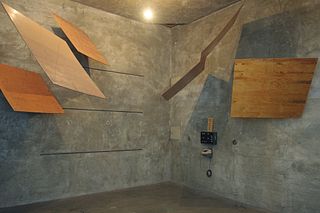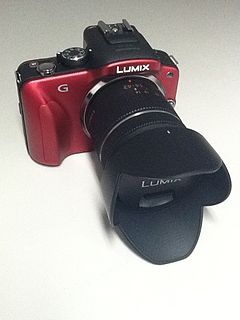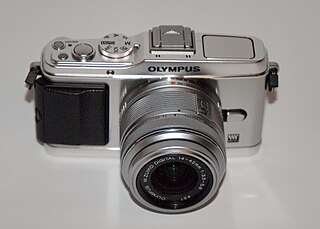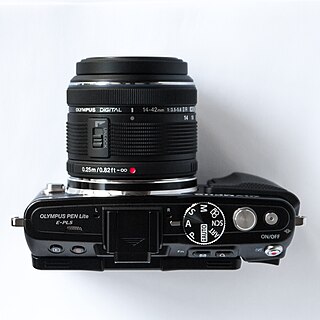
In telecommunication and signal processing companding is a method of mitigating the detrimental effects of a channel with limited dynamic range. The name is a portmanteau of the words compressing and expanding. The use of companding allows signals with a large dynamic range to be transmitted over facilities that have a smaller dynamic range capability. Companding is employed in telephony and other audio applications such as professional wireless microphones and analog recording.

A sound effect is an artificially created or enhanced sound, or sound process used to emphasize artistic or other content of films, television shows, live performance, animation, video games, music, or other media. These are normally created with foley. In motion picture and television production, a sound effect is a sound recorded and presented to make a specific storytelling or creative point without the use of dialogue or music. The term often refers to a process applied to a recording, without necessarily referring to the recording itself. In professional motion picture and television production, dialogue, music, and sound effects recordings are treated as separate elements. Dialogue and music recordings are never referred to as sound effects, even though the processes applied to such as reverberation or flanging effects, often are called "sound effects".
Olympus Corporation is a Japanese manufacturer of optics and reprography products. Olympus was established on 12 October 1919, initially specializing in microscopes and thermometers. Olympus holds roughly a 70-percent share of the global endoscope market, estimated to be worth approximately US$2.5 billion. Its global headquarters are located in Shinjuku, Tokyo, Japan.

A recording studio is a specialized facility for sound recording, mixing, and audio production of instrumental or vocal musical performances, spoken words, and other sounds. They range in size from a small in-home project studio large enough to record a single singer-guitarist, to a large building with space for a full orchestra of 100 or more musicians. Ideally both the recording and monitoring spaces are specially designed by an acoustician or audio engineer to achieve optimum acoustic properties.

Multitrack recording (MTR)—also known as multitracking, double tracking, or tracking—is a method of sound recording developed in 1955 that allows for the separate recording of multiple sound sources or of sound sources recorded at different times to create a cohesive whole. Multitracking became possible in the mid-1950s when the idea of simultaneously recording different audio channels to separate discrete "tracks" on the same reel-to-reel tape was developed. A "track" was simply a different channel recorded to its own discrete area on the tape whereby their relative sequence of recorded events would be preserved, and playback would be simultaneous or synchronized.

An echo chamber is a hollow enclosure used to produce reverberation, usually for recording purposes. For example, the producers of a television or radio program might wish to produce the aural illusion that a conversation is taking place in a large room or a cave; these effects can be accomplished by playing the recording of the conversation inside an echo chamber, with an accompanying microphone to catch the reverberation. Nowadays effects units are more widely used to create such effects, but echo chambers are still used today, such as the famous echo chambers at Capitol Studios.

In January 2004, Sony announced the Hi-MD media storage format as a further development of the MiniDisc format. With its release in later 2004, came the ability to use newly developed, high-capacity 1 gigabyte Hi-MD discs, sporting the same dimensions as regular MiniDiscs. The Hi-MD format can be considered obsolete as the last recorder/player was discontinued in 2011. The discs themselves were withdrawn from sale in September 2012, though regular MiniDiscs are still available.

The Microcassette is an audio storage medium, introduced by Olympus in 1969. It uses the same width of magnetic tape as the Compact Cassette but in a much smaller container. By using thinner tape and half or a quarter the tape speed, microcassettes can offer comparable recording time to the compact cassette. The original standard microcassette, the MC60, gives 30 minutes recording per side at its standard speed of 2.4 cm/s, and double that duration at 1.2 cm/s; an MC90, giving 45 minutes per side @ 2.4 cm/s, is also available from a few manufacturers. Unlike the Compact Cassette, a choice of recording speeds was provided on the original recorders and many others; the tape also spools in the opposite direction, from right to left. For transcription purposes, continuously variable speed was provided on many players.
Digital dictation is a method of recording and editing the spoken word in real-time. The recording is done by the use of a digital recorder. Digital recorders are lighter, have a longer battery life and are able to record for a lot longer utilizing the same media, as compared to analog tape based dictation machines. The files generated with digital recorders vary in size, depending on the manufacturer and the format the user chooses. The most common file formats that digital recorders generate have one of the extensions WAV, WMA or MP3. True dictation machines record in the DSS and DS2 format.
Digital Speech Standard (DSS) is a proprietary compressed digital audio file format defined by the International Voice Association, a co-operative venture by Olympus, Philips and Grundig Business Systems.

Field recording is the term used for an audio recording produced outside a recording studio, and the term applies to recordings of both natural and human-produced sounds.

A vocal coach, also known as a voice coach, is a music teacher, usually a piano accompanist, who helps singers prepare for a performance, often also helping them to improve their singing technique and take care of and develop their voice, but is not the same as a singing teacher. Vocal coaches may give private music lessons or group workshops or masterclasses to singers. They may also coach singers who are rehearsing on stage, or who are singing during a recording session. Vocal coaches are used in both Classical music and in popular music styles such as rock and gospel. While some vocal coaches provide a range of instruction on singing techniques, others specialize in areas such as breathing techniques or diction and pronunciation.
Musical "outboard equipment" or "gear" is used to alter how a musical instrument sounds. Outboard, (external effects units) can be used either during a live performance or in the recording studio. These are separate from the effects that may be applied by using a mixing console or a digital audio workstation. Some outboard effects units and digital signal processing (DSP) boxes commonly found in a studio are:

The Olympus Pen E-P2 announced on 5 November 2009 is Olympus Corporation's second camera that adheres to the Micro Four Thirds (MFT) system design standard. The E-P2 succeeds the Olympus Pen E-P1 a little over five months after the introduction of the EP-1.

The Panasonic Lumix DMC-G3 is a digital mirrorless interchangeable lens camera adhering to the joint Olympus and Panasonic Micro Four Thirds System (MFT) system design standard. The Panasonic Lumix DMC-G3 is the eighth Panasonic MFT camera introduced under the standard and the thirteenth model MFT camera introduced by either Olympus or Panasonic, as of the G3 product announcement date.
The Panasonic Lumix DMC-G10 is the sixth digital mirrorless interchangeable lens camera introduced that adheres to the Micro Four Thirds System (MFT) system design standard, and the fourth Panasonic model MFT camera. The G10 model was announced concurrently with its more capable sibling, the Panasonic Lumix DMC-G2, in March 2010.

The Olympus PEN E-P3 announced on 30 June 2011 is Olympus Corporation's seventh camera that adheres to the Micro Four Thirds (MFT) system design standard. The E-P3 succeeds the Olympus PEN E-P2, and was announced in concert with two other models, the Olympus PEN E-PL3, and the Olympus PEN E-PM1.

The Olympus PEN E-PL3 announced on June 30, 2011 is Olympus Corporation's seventh camera that adheres to the Micro Four Thirds (MFT) system design standard. The E-PL3 succeeds the Olympus PEN E-PL2, and was announced in concert with two other models, the Olympus PEN E-P3, and the Olympus PEN E-PM1. The E-PL3 is commonly said to be the "Lite" version of the E-P3, much as the E-PL1 and E-PL2 were "Lite" versions of the E-P1 and E-P2, respectively.

The Olympus PEN E-PL5, announced on September 17, 2012 is Olympus Corporation's tenth camera that adheres to the Micro Four Thirds (MFT) system design standard. The E-PL5 succeeds the Olympus PEN E-PL3, and was announced in concert with one other model, the Olympus PEN E-PM2.















